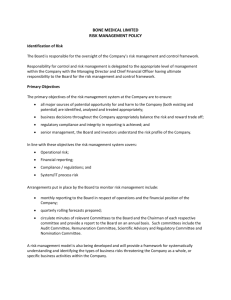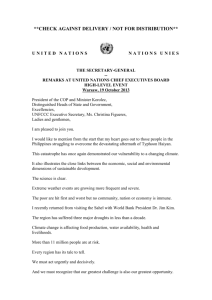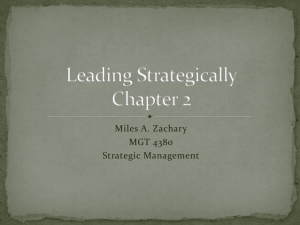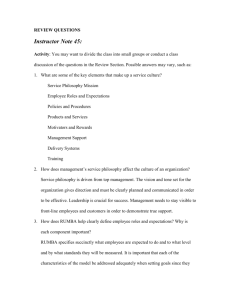Document
advertisement
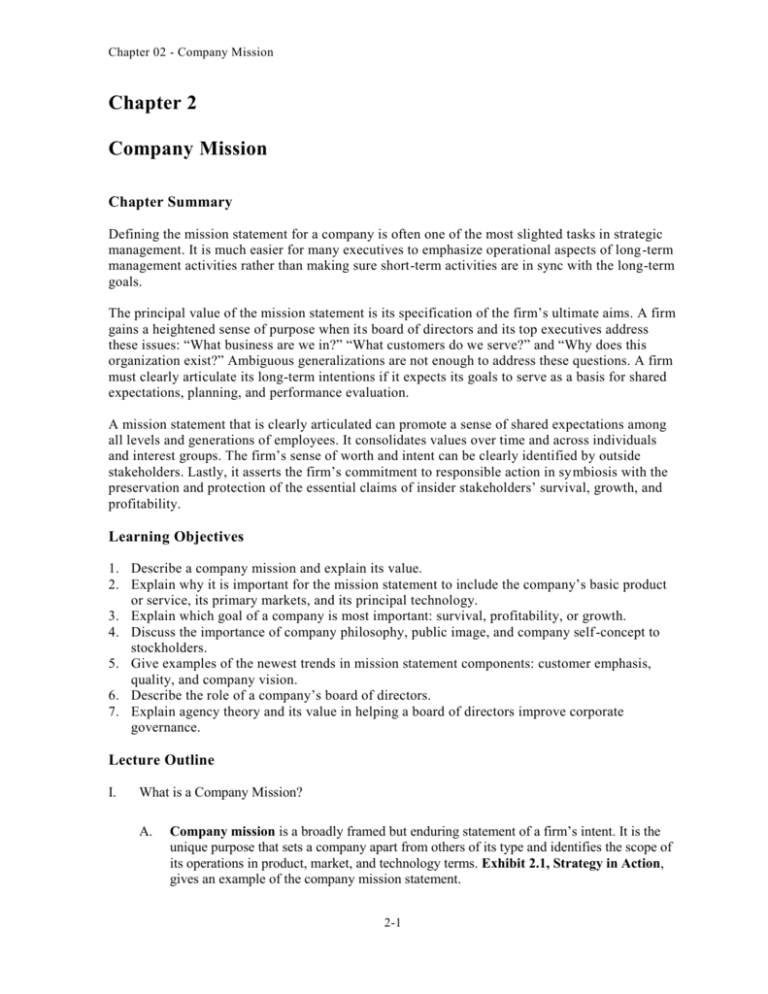
Chapter 02 - Company Mission Chapter 2 Company Mission Chapter Summary Defining the mission statement for a company is often one of the most slighted tasks in strategic management. It is much easier for many executives to emphasize operational aspects of long-term management activities rather than making sure short-term activities are in sync with the long-term goals. The principal value of the mission statement is its specification of the firm’s ultimate aims. A firm gains a heightened sense of purpose when its board of directors and its top executives address these issues: “What business are we in?” “What customers do we serve?” and “Why does this organization exist?” Ambiguous generalizations are not enough to address these questions. A firm must clearly articulate its long-term intentions if it expects its goals to serve as a basis for shared expectations, planning, and performance evaluation. A mission statement that is clearly articulated can promote a sense of shared expectations among all levels and generations of employees. It consolidates values over time and across individuals and interest groups. The firm’s sense of worth and intent can be clearly identified by outside stakeholders. Lastly, it asserts the firm’s commitment to responsible action in symbiosis with the preservation and protection of the essential claims of insider stakeholders’ survival, growth, and profitability. Learning Objectives 1. Describe a company mission and explain its value. 2. Explain why it is important for the mission statement to include the company’s basic product or service, its primary markets, and its principal technology. 3. Explain which goal of a company is most important: survival, profitability, or growth. 4. Discuss the importance of company philosophy, public image, and company self -concept to stockholders. 5. Give examples of the newest trends in mission statement components: customer emphasis, quality, and company vision. 6. Describe the role of a company’s board of directors. 7. Explain agency theory and its value in helping a board of directors improve corporate governance. Lecture Outline I. What is a Company Mission? A. Company mission is a broadly framed but enduring statement of a firm’s intent. It is the unique purpose that sets a company apart from others of its type and identifies the scope of its operations in product, market, and technology terms. Exhibit 2.1, Strategy in Action, gives an example of the company mission statement. 2-1 Chapter 02 - Company Mission 1. The Need for an Explicit Mission a) b) c) d) No external body requires a company to define its mission. Furthermore, defining it can be time-consuming and tedious. It contains broadly outlined objectives and strategies rather than specific directives. The mission statement is a message designed to include the expectations of all stakeholders regarding company performance over the long run. The writers attempt to provide a unifying purpose for the company that will provide a basis for strategic objective setting and decision making. Mission statements address the following questions: (1) (2) (3) (4) (5) (6) II. Why is this firm in business? What are our economic goals? What is our operating philosophy in terms of quality, company image, and self-concept? What are our core competencies and competitive advantages? What customers do and can we serve? How do we view our responsibilities to stockholders, employees, communities, environment, social issues, and competitors? Formulating a Mission A. The typical business begins with the beliefs, desires, and aspirations of a single entrepreneur. 1. Such an owner-manager’s sense of mission usually is based on the following fundamental beliefs: a) b) c) d) e) f) 2. The product or service of the business can provide benefits at least equal to its price. The product or service can satisfy a customer need of specific market segments that is currently not being met adequately. The technology that is to be used in production will provide a cost- and qualitycompetitive product or service. With hard work and the support of others, the business can not only survive but also grow and be profitable. The management philosophy of the business will result in a favorable public image and will provide financial and psychological rewards for those who are willing to invest their labor and money in helping the business succeed. The entrepreneur’s self-concept of the business can be communicated to and adopted by employees and stockholders. As the business grows or is forced to alter its product, market, or technology, redefining the company mission may be necessary. Exhibit 2.2, Strategic Action, illustrates the components of a mission statement. 2-2 Chapter 02 - Company Mission B. Basic Product or Service; Primary Market; Principal Technology 1. 2. C. Three indispensable components of the mission statement are specification of the basic product or service, specification of the primary market, and specification of the principal technology for production or delivery. They are only descriptive of the business when they are shown in combination with each other. Often the most referenced public statement of a company’s selected products and markets appears in “silver bullet” form in the mission statement. Sometimes outsider’s value condensed overviews of the mission. Company Goals: Survival; Growth; Profitability 1. Three economic goals guide the strategic direction of almost every business. The mission reflects the firm’s intention to secure survival through growth and profitability. 2. A firm that is unable to survive will be incapable of satisfying the aims of any of its stakeholders. a. b. 3. A firm’s profitability is the mainstay goal of a business. a. b. c. d. 4. Often, survival is taken for granted to the point of being neglected as a principal criterion in strategic decision making. When this happens, the firm may focus on the short run at the expense of the long run. Concerns for a quick fix or a bargain may displace the assessment of longterm impact. The result can be near-term economic failure owing to a lack of resource synergy and sound business practice. No matter how profit is measured or defined, profit over the long term is the clearest indication of a firm’s ability to satisfy the principal claims and desires of employees and stockholders. The emphasis is over the long term. Basing decisions on a short-term concern for profitability would lead to strategic myopia. Overlooking the enduring concerns of customers, suppliers, creditors, ecologists, and regulatory agents may product profit in the short term, but, over time, the financial consequences are likely to be detrimental. A firm’s growth is tied inextricably to its survival and profitability. Growth in this sense must be broadly defined. a. Although product impact market studies (PIMS) have shown that growth in market share is correlated with profitability, other important forms of growth do exist. (1) Growth in the number of markets served, in the variety of products offered, and in the technologies that are used frequently leads to improvements in a firm’s competitive ability. (2) Growth means change, and proactive change is essential in a dynamic business environment. 2-3 Chapter 02 - Company Mission b. c. D. Company Philosophy 1. The statement of a company’s philosophy, often called company creed, usually accompanies or appears within the mission statement. It reflects the basic beliefs, values, aspirations, and philosophical priorities to which strategic decision makers are committed in managing the company. a. b. Fortunately, the philosophies vary little from one firm to another. Owners and managers implicitly accept a general, unwritten, yet pervasive code that governs business actions and allows them to be largely self-regulated. Unfortunately, statements of philosophy are often so similar and so platitudinous that they read more like PR handouts than commitments to values. 2. Exhibit 2.3, Strategy in Action, demonstrates Saturn’s statement of philosophy. It indicates the company’s clearly defined initiatives for satisfying its stakeholders. 3. Exhibit 2.4, Strategy in Action, shows AIM’s board of directors and executives have established especially clear directions for company decision making and action based on growth. 4. Exhibit 2.5, Global Strategy in Action, shows how the philosophy of Nissan Motor Manufacturing is expressed by the company’s People Principles and Key Corporate Principles. a. b. c. d. 5. 6. E. The issue of growth raises a concern about the definition of the company mission. How can we have an effective, complete mission statement without precluding the exercise of unanticipated strategic options? A mission statement can outline the conditions under which the firm might depart from ongoing operations. They form the basis of the way the company operates on a daily basis. They address the principal concepts used in meeting the company’s established goals. Employees can link their productivity and success to the productivity and success of the company. Given these principles, the company is able to concentrate on the issues most important to its survival, growth, and profitability. Exhibit 2.6, Strategy in Action, provides an example of how GM uses a statement of company philosophy to clarify its environmental principles. Exhibit 2.7, Top Strategist, profiles Aetna’s CEO’s quest to fulfill the company’s mission. Public Image 1. Both present and potential customers attribute certain qualities to particular businesses. 2-4 Chapter 02 - Company Mission a. b. 2. Firms seldom address the question of their public image in an intermittent fashion. a. b. F. Although public agitation often stimulates greater attention to this questi on, firms are concerned about their public image in even in the absence of such agitation. Exhibit 2.8, Strategy in Action, presents a marketing translation of the essence of mission statements of six high-end shoe companies. The impressive feature is that closely competing firms can incorporate subtle, yet meaningful, differences into their mission statements. Company Self-Concept 1. A major determinant of a firm’s success is the extent to which the firm can relate functionally to its external environment. a. b. 2. c. d. e. 3. To achieve its proper place in a competitive situation, the firm must realistically evaluate its competitive strengths and weaknesses. This idea is the essence of the company self-concept. The idea is not commonly integrated into theories of strategic management; still, its importance for individuals has been recognized since ancient times. The ability of firms to survive in a dynamic and highly competitive environment would be severely limited if they did not understand their impact on others or of others on them. a. b. G. Mission statements should reflect the public’s expectations, because this makes achievement of the firm’s goals more likely. A negative public image often prompts firms to reemphasize the beneficial aspects of their mission. Firms take on personalities of their own. Much behavior is organizationally based; it acts on its members in other ways than their individual interactions. Firms are entities whose personality transcends the personalities of their members. They can set decision-making parameters based on different aims and distinct from the aims of their members. These organizational considerations have pervasive effects. Ordinarily, descriptions of the company self-concept per se do not appear in mission statements. Newest Trends in Mission Components 1. Recently, several issues have become so important in the strategic planning process that they are increasingly becoming integral parts in the development and revisions of mission statements: sensitivity to consumer wants, concern for quality, and statements of company vision. 2-5 Chapter 02 - Company Mission 2. Customers “The customer is our top priority” is a slogan that would be claimed by the majority of businesses in the United States and abroad. Many U.S. firms maintain extensive product safety programs to help ensure consumer satisfaction. Some provide toll-free telephone lines to answer customer concerns and complaints. A focus on customer satisfaction causes managers to realize the importance of providing quality customer service. Strong customer service initiatives have led some firms to gain competitive advantages in the marketplace. Hence, many corporations have made customer service a key component of developing corporate mission. a. b. c. d. 3. Quality a. b. c. “Quality is job one!” is a rallying point for many resurging U.S. businesses. W. Edwards Deming and J. M. Juran’s messages foster a worldwide emphasis on quality in manufacturing. Deming’s ideas are summarized in 14 points: (1) (2) (3) (4) (5) (6) (7) (8) (9) (10) (11) (12) (13) (14) d. e. Create constancy of purpose. Adopt the new philosophy. Cease dependence on mass inspection to achieve quality. End the practice of awarding business on price tag alone. Instead, minimize total cost, often accomplished by working with a single supplier. Improve constantly the system of production and service. Institute training on the job. Institute leadership. Drive out fear. Break down barriers between departments. Eliminate slogans, exhortations, and numerical targets. Eliminate work standards (quotas) and management by objective. Remove barriers that rob workers, engineers, and managers of their right to pride of workmanship. Institute a vigorous program of education and self-improvement. Put everyone in the company to work to accomplish the transformation. Firms in the United States responded aggressively. The new philosophy is that quality should be the norm. Exhibit 2.9, Strategy in Action, presents the integration of the quality initiative into the mission statements of three corporations. 2-6 Chapter 02 - Company Mission 4. Vision Statement a. b. c. d. e. H. The vision statement is a statement that presents a firm’s strategic intent designed to focus the energies and resources of the company on achieving a desirable future. A vision statement and mission statement are frequently combined into a single statement in actual practice. When they are separated, a vision statement is usually a memorable single sentence. A vision is often expressed as a unique way to combine competitive influences in a way that directs a firm to pursue a revolutionary strategy. Exhibit 2.10 gives examples of vision statements. An Exemplary Mission Statement 1. 2. The Chapter 2 Appendix presents BB&T’s vision, mission, and purpose statement in its entirety. It also includes detailed expressions of the company’s values and views on the role of emotions, management style, the management concept, attributes of an outstanding employee, the importance of positive attitude, obligations to its employees, virtues of an outstanding credit culture, achieving the company goal, the nature of a “world standard” revenue-driven sales organization, the nature of a “world-standard” client service community bank, the company’s commitment to education and learning, and its passions. III. Boards of Directors A. Strategic decision makers are responsible for the following: 1. Determining the firm’s mission 2. Acquiring and allocating resources so the firm can thoughtfully develop and implement a strategic plan 3. Monitoring the firm’s success in the competitive marketplace to determine whether that plan was well designed and activated B. Most organizations have multiple levels of strategic decision makers; typically, the larger the firm, the more levels it will have. C. The board of directors is the group of stockholder representatives and strategic managers responsible for overseeing the creation and accomplishment of the company mission. 1. 2. The board operates as the representatives of the firm’s stockholders. Elected by the stockholders, the board has these major responsibilities: a. b. c. d. To establish and update the company mission. To elect the company’s top officers, the foremost of whom is the CEO. To establish the compensation levels of the top officers, including their salaries and bonuses. To determine the amount and timing of the dividends paid to stockholders. 2-7 Chapter 02 - Company Mission e. f. e. 3. 4. 5. To set broad company policy on such matters as labor-management relations, product or service lines of business, and employee benefit packages. To set company objectives and to authorize managers to implement the longterm strategies that the top officers and the board have found agreeable. To mandate company compliance with legal and ethical dictates. In the current business environment, boards of directors are accepting the challenge of shareholders and other stakeholders to become active in establishing the strategic initiatives of the companies that they serve. The board’s greatest impact on the behavior of a firm results from its determination of the company mission. The philosophy espoused in the company mission sets the tone by which the firm and all of its employees will be judged. Through its appointment of top executives and its decisions about their compensation, the board reveals its priorities for organizational achievement. IV. Agency Theory A. Whenever there is a separation of the owners (principals) and the managers (agents) of a firm, the potential exists for the wishes of the owner to be ignored. 1. 2. 3. 4. Agency theory is a set of ideas on organizational control based on the belief that the separation of the ownership from management creates the potential for the wishes of owners to be ignored. Whenever owners (or managers) delegate decision-making authority to others, the agency relationship exists between the two parties. Agency relationships can be very effective as long as managers make investment decisions in ways that are consistent with stockholders’ interests. When the interests of managers diverge from those of owners, then managers’ decisions are more likely to reflect the managers’ preferences than the owners’ preferences. a. b. c. 5. In general, owners seek stock value maximization. When managers hold important blocks of company stock, they too prefer strategies that result in stock appreciation. However, when managers resemble “hired hands” more than owner-partners, they often prefer strategies that increase their personal payoffs rather than those of shareholders. If, as agency theory argues, self-interested managers act in ways that increase their own welfare at the expense of the gain of corporate stockholders, then owners who delegate decision-making authority to their agents will incur both the loss of potential gain that would have resulted from owner-optimal strategies and/or the costs of monitoring and control systems that are designed to minimize the consequences of such self-centered management decisions. a. b. The cost of agency problems plus the cost of actions taken to minimize agency problems are collectively termed agency costs. Agency costs can often be identified by their direct benefit for the agents and their negative present value. 2-8 Chapter 02 - Company Mission c. B. How Agency Problems Occur 1. 2. 3. Because owners have access to only a relatively small portion of the information that is available to executives about the performance of the firm and cannot afford to monitor every executive decision or action, executives are often free to pursue their own interests. This is the moral hazard problem. As a result of moral hazards, executives may design strategies that provide the greatest possible benefits for themselves, with the welfare of the organization being given only secondary consideration. Unchecked executives may advance their own self-interests by doing the following: a. b. c. d. 4. 5. 6. Slacking on the job Altering forecasts to maximize their performance bonuses Unrealistically assessing acquisition targets’ outlooks in order to increase the probability of increasing organizational size through their acquisition Manipulating personnel records to keep or acquire key company personnel A second major reason for agency costs is adverse selection: an agency problem caused by the limited ability of stockholders to precisely determine the competencies and priorities of executives at the time they are hired. Because principals cannot initially verify an executive’s appropriateness as an agent of the owners, unanticipated problems of non-overlapping priorities between owners and agents are likely to occur. The most popular solution to moral dilemma and adverse selection problems is for owners to attempt to more closely align their own best interests with those of agents through use of executive bonus plans. a. b. c. C. Agency costs are found when there are differing self-interests between shareholders and managers, superiors and subordinates, or managers of competing departments or branch offices. Foremost among these plans are stock option plans, which enable executives to benefit directly from the appreciation of the company’s stock just as other stockholders do. Mostly, executive bonus plans are unabashed attempts to align the interests of the owners and executives and to thereby induce executives to support strategies that increase stockholder wealth. These plans do help to reduce the costs associated with moral dilemmas and adverse selections. Problems That Can Result from Agency 1. From a strategic management perspective there are five different kinds of problems that can arise because of the agency relationship between corporate stockholders and their company’s executives: a. Executives pursue growth in company size rather than earnings. (1) Shareholders generally want to maximize earnings, because earnings growth yields stock appreciation. 2-9 Chapter 02 - Company Mission (2) Because managers are typically more heavily compensated for increases in firm size than for earnings growth, they may recommend strategies that yield company growth such as mergers and acquisitions. (3) Managers’ stature in the business community is commonly associated with company size. This benefits them in job mobility and career advancement. (4) Executives need an enlarging set of advancement opportunities for subordinates whom they wish to motivate with nonfinancial inducements. Acquisitions can provide the needed positions. b. Executives attempt to diversify their corporate risk. (1) Stockholders can vary their investment risks through management of their individual stock portfolios. Managers’ careers and stock incentives, however, are tied to the performance of a single corporation (albeit one that employs them). (2) Executives are tempted to diversify their corporation’s operation, businesses, and product lines to moderate the risk incurred in any single venture. (3) This approach serves the executives’ personal agendas and compromises the “pure play” quality of their firm as an investment. (4) Diversifying a corporation reduces the beta associated with the firm’s return, which is an undesirable outcome for many stockholders. c. Executives avoid risk. (1) Executives are willing to restrict the diversification of their companies, and are tempted to minimize the risk that they face. (2) Executives are often fired for failure, but rarely for mediocre corporate performance. (3) Therefore, executives may avoid desirable levels of risk, if they anticipate little reward and opt for conservative strategies that minimize the risk of company failure. (4) If they do avoid desirable levels of risk, executives will rarely support plans for innovation, diversification, and rapid growth. (5) From an investor’s perspective, risk taking is desirable when it is systematic—when investors can reasonably expect that their company will generate higher long-term returns from assuming greater risk. (6) The agency problem creates a problem—should executives prioritize their job security or the company’s financial returns to stockholders? d. Managers act to optimize their personal payoffs. (1) If executives can gain more from an annual performance bonus by achieving objective 1 than from stock appreciation resulting from the achievement of objective 2, then owners must anticipate that the executives will target objective 1 and their priority, even though objective 2 is clearly in the best interest of the shareholders. (2) Executives may pursue a range of expensive perquisites that have a net negative effect on shareholder returns. These include elegant corner offices, corporate jets, large staffs, golf memberships, limousines, etc. 2-10 Chapter 02 - Company Mission e. Executives act to protect their status. (1) When their companies expand, executives want to ensure that their knowledge, experience, and skills remain relevant and central to the strategic direction of the corporation. (2) Executives favor doing more of what they already do well. (3) On the other hand, investors may prefer revolutionary advancement to incremental improvement. (4) Revolutionary strategies are most likely to occur when executives are given assurances that they will not make themselves obsolete within the changing company that they create. D. Solutions to the Agency Problem a. In addition to defining an agent’s responsibilities in a contract and including elements like bonus incentives that help align executives’ and owners’ interests, principals can take several other actions to minimize agency problems: (1) Owners pay executives a premium for their service. This helps executives to see their loyalty to the stockholders as key to achieving personal financial targets. (2) Executives receive backloaded compensation. This means executives are paid a handsome premium for superior future performance. (3) Creating teams of executives across different units of a corporation can help to focus performance measures on organizational rather than personal goals. Owners’ interests receive deserving priority. Questions for Discussion 1. Reread Nicor Inc.’s mission statement in Exhibit 2.1, Strategy in Action. List five insights into Nicor that you feel you’ve gained from knowing its mission. Reading the mission statement of Nicor, Inc. reveals the following things about the company: It is involved in the energy business. While it competes in the area of providing energy to consumers, it may engage in other related activities. It operates primarily in the United States. It recognizes that it has various stakeholders, each with their own interests. Thus, it explicitly identifies stakeholders such as investors, customers, employees, and the public. It recognizes its ecological responsibilities by stating its concern for the optimum utilization of natural resources. It seeks to earn optimum, long-range profits for its investors. 2-11 Chapter 02 - Company Mission 2. Locate the mission statement of a company not mentioned in the chapter. Where did you find it? What it presented as a consolidated statement, or were you forced to assemble it yourself from various publications of the firm? How many of the mission statement elements outlined in this chapter were discussed or revealed in the statement you found? There are various sources for obtaining companies’ mission statements. One can write to the company and ask for an investor packet, which very likely would include the company’s mission. The most common way today is to access the company’s website and obtain the mission statement through that. In the case of most companies, the mission would be a consolidated statement. For example the website www.ge.com is the website of General Electric. GE’s mission statement is on the website. Dow Chemical’s mission is also on its web site www.dowchemical.com. It is unlikely that all the mission statements contain all the elements mentioned in the chapter. 3. Prepare a two-page typewritten mission statement for your school of business or for a firm selected by your instructor. This is a good exercise designed to help students develop an actual mission statement, e ither for their school of business or for a selected firm. In practice, most organizations use a participatory approach (for example, the faculty members of the business school may meet several times to develop their school’s mission) to develop mission statements. The instructor may design this as an individual or a group exercise. 4. List five potentially vulnerable areas of a firm without a stated company mission. A good way to approach this question is to look at each of the mission statement components discussed in the chapter and ask what would happen to the firm if this component were not included. Without a mission, the following areas could be vulnerable: identification of competitors because of lack of definition of basic product or service identification of competitors because of lack of definition of primary market no common agreement among employees regarding growth and profitability no sense of the basic philosophy – beliefs, values, etc. confusion about the public image that the company wants to project confusion about its own strengths and weaknesses 2-12 Chapter 02 - Company Mission 5. Mission statements are often criticized for being lists of platitudes. What can strategic managers do to prevent their statements from appearing to be simple statements of obvious truths? A company’s philosophy is often stated in the company creed, which accompanies or appears within the mission statement. Creeds are written statements regarding the company, and actually vary little from one company to the next. This is one element of the mission statement that can be perceived as largely platitudinous (see “Company Philosophy”). One way for strategic managers to make the mission statement less platitudinous is to highlight the differences between their firm and the next. They should differentiate the firm’s mission statement just as they actually differentiate the firm and its products or services. A company that can list a unique perspective in its mission will be perceived as original and not the “same as the rest.” Also, they should make sure to emphasize how they actually practice integrity or commitment to the environment, etc. Instead of listing a passive statement about beliefs, they could show dynamic examples of how they put those beliefs into practice. 6. What evidence do you see that mission statements are valuable? Mission statements are a useful tool companies use to communicate with their employees, managers, community, potential investors, and outside stakeholders. The mission statement can provide a clear link between individual and company-wide senses of purpose. Using key principles outlined in the mission statement, a company is able to concentrate on the most important aspects of its business: survival through growth and profitability. It can outline the general ways in which these goals can be accomplished and demonstrate to everyone where their strongest strategic commitments lay. 7. How can a mission statement be an enduring statement of values and simultaneously provide a basis of competitive advantage? The mission statement is designed to provide insight into a company’s values. Values are sustained over the course of the company’s existence. They are long-term declarations of how the company and its employees should manage its business affairs. Still, the mission should convey competitive advantage. The goals of survival, growth, and profitability are dependent on good strategies to achieve sustainable competitive advantages. Long-term statements about values and principles do not negate a company’s flexibility or adaptability in achieving competitive advantage. (See section titled “Company Goals: Survival; Growth; Profitability.”) 8. If the goal of survival refers to ability to maintain a specific legal form, what are the comparative advantages of sole proprietorships, partnerships, and corporations? The advantages of sole proprietorships include: ease of establishment, independence, secrecy (your plans do not have to be revealed to anyone), and tax advantages (pay taxes at personal income tax rate). The advantages for partnerships include: easy to form and taxed at personal income tax rate, greater profit potential due to pooled talents, can raise money quicker than proprietorships and generally have higher credit ratings, and may have a longer life span. Both of these forms have unlimited liabilities and limited resource issues. Also limited life and managerial problems may be an issue. Finally, the corporations’ advantages include: power to bring together large sums of capital, resources, and talent; limited liability; liquidity; and unlimited life span. Some disadvantages may be cumbersome paperwork, public disclosure of finances and operations, and higher tax rates. 2-13 Chapter 02 - Company Mission 9. In the 1990s many Nasdaq firms favored growth over profitability; in the 2000s the goal of profitability is displacing growth. How might each preference be explained? Profitability is the mainstay goal of a business. Profit over the long term is the clearest indication of a firm’s ability to satisfy the principal claims and desires of employees and stockholders. The key to profitability is long-term results. Growth on the other hand is about increasing the size of the firm in one of the various ways: growth in the number of markets served, in the variety of products offered, and in the technologies that are used to provide goods or services. In the 1990s, companies that grew were favored and were their stocks were valued highly on the expectation that those firms, particularly Internet-based “dot-coms,” would be profitable in the future based on their large market shares. Today, profitability is the number one factor in determining the financial valuation of stocks. One key point is that no matter what goals the company is measured by, it should be evaluated on the basis of its long-term viability, not short-term results or goals. For more explanation, refer to “Company Goals: Survival; Growth; Profitability.” 10. Do you agree that a mission statement provides substantive guidance while a vision statement provides inspirational guidance? Explain. Students’ responses will vary. A mission statement is meant to provide long-term guidance regarding what a firm does, what customers it serves, and what principles are most important to the company as a whole. It includes more information than the vision statement, which is easy to remember, usually only one or two sentences long. The vision statement has to be more inspirational and make its point more quickly than the mission. It is also developed to express the aspirations of the firm, whereas the mission statement shows what business the company is in now. For more explanation, refer to “Vision Statement,.” 2-14


